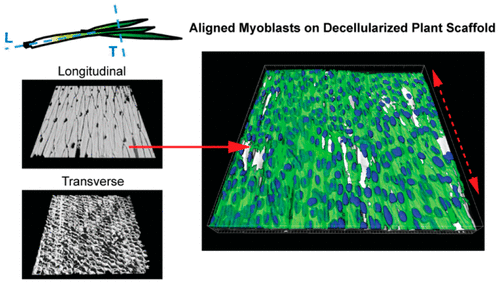当前位置:
X-MOL 学术
›
ACS Biomater. Sci. Eng.
›
论文详情
Our official English website, www.x-mol.net, welcomes your feedback! (Note: you will need to create a separate account there.)
Engineering Aligned Skeletal Muscle Tissue Using Decellularized Plant-Derived Scaffolds
ACS Biomaterials Science & Engineering ( IF 5.8 ) Pub Date : 2020-03-10 , DOI: 10.1021/acsbiomaterials.0c00058 Ya-Wen Cheng , Daniel J Shiwarski , Rebecca L Ball , Kathryn A Whitehead , Adam W Feinberg
ACS Biomaterials Science & Engineering ( IF 5.8 ) Pub Date : 2020-03-10 , DOI: 10.1021/acsbiomaterials.0c00058 Ya-Wen Cheng , Daniel J Shiwarski , Rebecca L Ball , Kathryn A Whitehead , Adam W Feinberg

|
To achieve organization and function, engineered tissues require a scaffold that supports cell adhesion, alignment, growth, and differentiation. For skeletal muscle tissue engineering, decellularization has been an approach for fabricating 3D scaffolds that retain biological architecture. While many decellularization approaches are focused on utilizing animal muscle as the starting material, decellularized plants are a potential source of highly structured cellulose-rich scaffolds. Here, we assessed the potential for a variety of decellularized plant scaffolds to promote mouse and human muscle cell alignment and differentiation. After decellularizing a range of fruits and vegetables, we identified the green-onion scaffold to have appropriate surface topography for generating highly confluent and aligned C2C12 and human skeletal muscle cells (HSMCs). The topography of the green-onion cellulose scaffold contained a repeating pattern of grooves that are approximately 20 μm wide by 10 μm deep. The outer white section of the green onion had a microstructure that guided C2C12 cell differentiation into aligned myotubes. Quantitative analysis of C2C12 and HSMC alignment revealed an almost complete anisotropic organization compared to 2D isotropic controls. Our results demonstrate that the decellularized green onion cellulose scaffolds, particularly from the outer white bulb segment, provide a simple and low-cost substrate to engineer aligned human skeletal muscle.
中文翻译:

使用脱细胞植物源性支架设计对齐的骨骼肌组织
为了实现组织和功能,工程化组织需要支持细胞粘附、排列、生长和分化的支架。对于骨骼肌组织工程,去细胞化一直是制造保留生物结构的 3D 支架的一种方法。虽然许多脱细胞方法都集中在利用动物肌肉作为起始材料,但脱细胞植物是高度结构化富含纤维素的支架的潜在来源。在这里,我们评估了各种脱细胞植物支架促进小鼠和人类肌肉细胞排列和分化的潜力。在对一系列水果和蔬菜进行脱细胞后,我们确定大葱支架具有适当的表面形貌,用于生成高度融合和对齐的 C2C12 和人类骨骼肌细胞 (HSMC)。大葱纤维素支架的形貌包含大约 20 μm 宽、10 μm 深的重复凹槽图案。葱的外部白色部分具有引导 C2C12 细胞分化成对齐的肌管的微结构。与 2D 各向同性对照相比,C2C12 和 HSMC 对齐的定量分析揭示了几乎完整的各向异性组织。我们的研究结果表明,脱细胞的葱纤维素支架,特别是来自外部白色灯泡部分,为设计对齐的人类骨骼肌提供了一种简单且低成本的基材。大葱纤维素支架的形貌包含大约 20 μm 宽、10 μm 深的重复凹槽图案。葱的外部白色部分具有引导 C2C12 细胞分化成对齐的肌管的微结构。与 2D 各向同性对照相比,C2C12 和 HSMC 对齐的定量分析揭示了几乎完整的各向异性组织。我们的研究结果表明,脱细胞的葱纤维素支架,特别是来自外部白色灯泡部分,为设计对齐的人类骨骼肌提供了一种简单且低成本的基材。大葱纤维素支架的形貌包含大约 20 μm 宽、10 μm 深的重复凹槽图案。葱的外部白色部分具有引导 C2C12 细胞分化成对齐的肌管的微结构。与 2D 各向同性对照相比,C2C12 和 HSMC 对齐的定量分析揭示了几乎完整的各向异性组织。我们的研究结果表明,脱细胞的葱纤维素支架,特别是来自外部白色灯泡部分,为设计对齐的人类骨骼肌提供了一种简单且低成本的基材。与 2D 各向同性对照相比,C2C12 和 HSMC 对齐的定量分析揭示了几乎完整的各向异性组织。我们的研究结果表明,脱细胞的葱纤维素支架,特别是来自外部白色灯泡部分,为设计对齐的人类骨骼肌提供了一种简单且低成本的基材。与 2D 各向同性对照相比,C2C12 和 HSMC 对齐的定量分析揭示了几乎完整的各向异性组织。我们的研究结果表明,脱细胞的葱纤维素支架,特别是来自外部白色灯泡部分,为设计对齐的人类骨骼肌提供了一种简单且低成本的基材。
更新日期:2020-03-10
中文翻译:

使用脱细胞植物源性支架设计对齐的骨骼肌组织
为了实现组织和功能,工程化组织需要支持细胞粘附、排列、生长和分化的支架。对于骨骼肌组织工程,去细胞化一直是制造保留生物结构的 3D 支架的一种方法。虽然许多脱细胞方法都集中在利用动物肌肉作为起始材料,但脱细胞植物是高度结构化富含纤维素的支架的潜在来源。在这里,我们评估了各种脱细胞植物支架促进小鼠和人类肌肉细胞排列和分化的潜力。在对一系列水果和蔬菜进行脱细胞后,我们确定大葱支架具有适当的表面形貌,用于生成高度融合和对齐的 C2C12 和人类骨骼肌细胞 (HSMC)。大葱纤维素支架的形貌包含大约 20 μm 宽、10 μm 深的重复凹槽图案。葱的外部白色部分具有引导 C2C12 细胞分化成对齐的肌管的微结构。与 2D 各向同性对照相比,C2C12 和 HSMC 对齐的定量分析揭示了几乎完整的各向异性组织。我们的研究结果表明,脱细胞的葱纤维素支架,特别是来自外部白色灯泡部分,为设计对齐的人类骨骼肌提供了一种简单且低成本的基材。大葱纤维素支架的形貌包含大约 20 μm 宽、10 μm 深的重复凹槽图案。葱的外部白色部分具有引导 C2C12 细胞分化成对齐的肌管的微结构。与 2D 各向同性对照相比,C2C12 和 HSMC 对齐的定量分析揭示了几乎完整的各向异性组织。我们的研究结果表明,脱细胞的葱纤维素支架,特别是来自外部白色灯泡部分,为设计对齐的人类骨骼肌提供了一种简单且低成本的基材。大葱纤维素支架的形貌包含大约 20 μm 宽、10 μm 深的重复凹槽图案。葱的外部白色部分具有引导 C2C12 细胞分化成对齐的肌管的微结构。与 2D 各向同性对照相比,C2C12 和 HSMC 对齐的定量分析揭示了几乎完整的各向异性组织。我们的研究结果表明,脱细胞的葱纤维素支架,特别是来自外部白色灯泡部分,为设计对齐的人类骨骼肌提供了一种简单且低成本的基材。与 2D 各向同性对照相比,C2C12 和 HSMC 对齐的定量分析揭示了几乎完整的各向异性组织。我们的研究结果表明,脱细胞的葱纤维素支架,特别是来自外部白色灯泡部分,为设计对齐的人类骨骼肌提供了一种简单且低成本的基材。与 2D 各向同性对照相比,C2C12 和 HSMC 对齐的定量分析揭示了几乎完整的各向异性组织。我们的研究结果表明,脱细胞的葱纤维素支架,特别是来自外部白色灯泡部分,为设计对齐的人类骨骼肌提供了一种简单且低成本的基材。


























 京公网安备 11010802027423号
京公网安备 11010802027423号